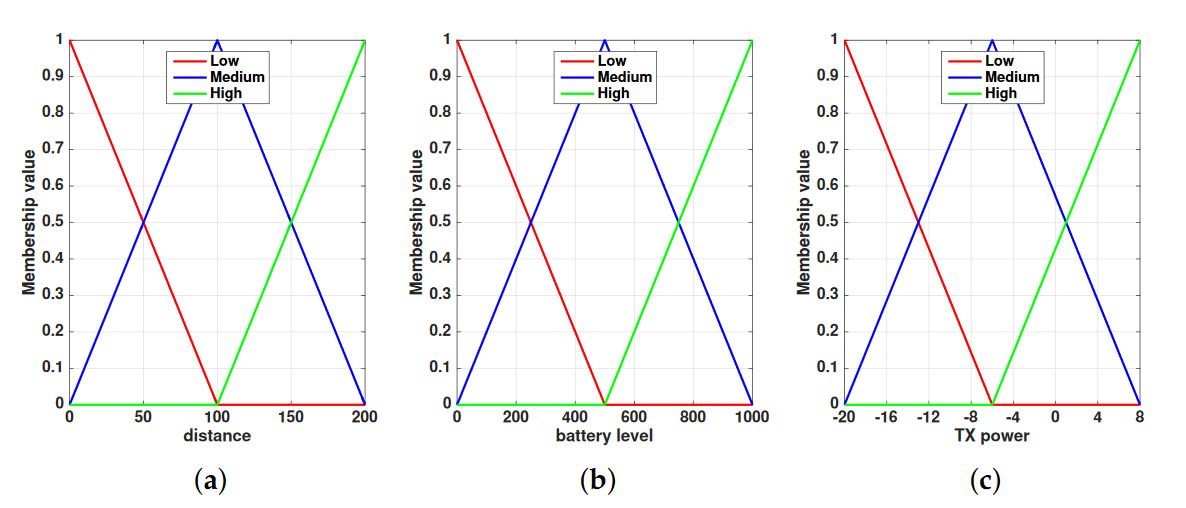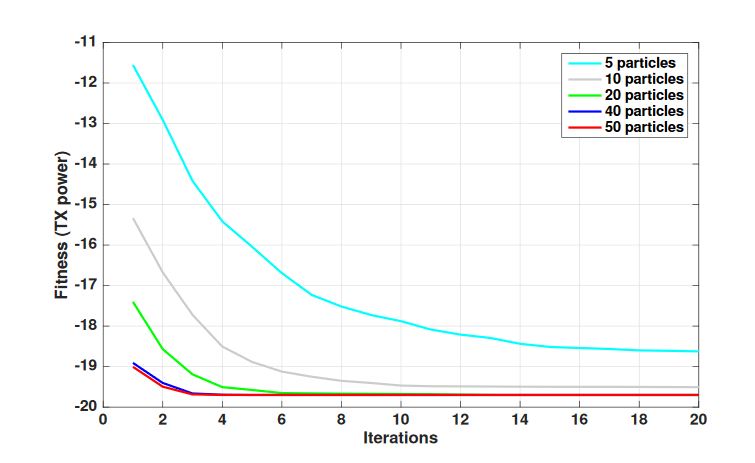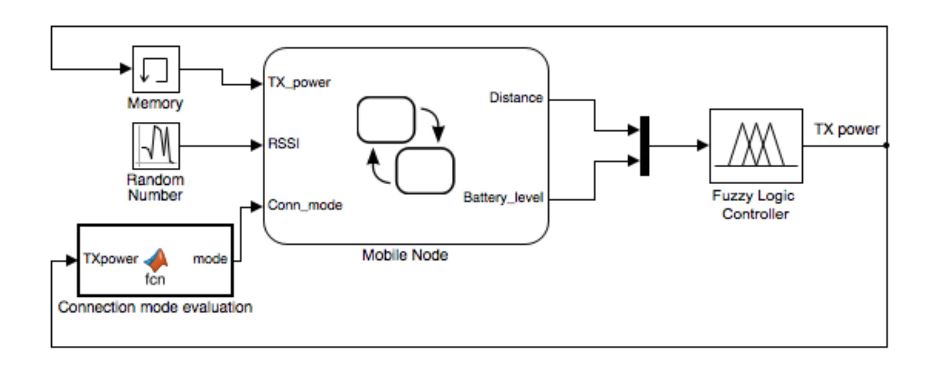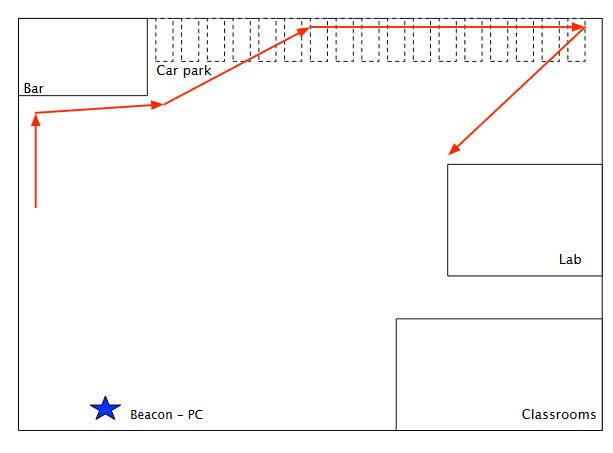ABSTRACT
Energy efficiency is a fundamental requirement for a wireless protocol to be suitable for use within the Internet of Things. New technologies are emerging aiming at an energy-efficient communication. Among them, Bluetooth Low Energy is an appealing solution. Recently, the specifications of Bluetooth 5 have been presented with the purpose to offer significant enhancements compared to the earlier versions of the protocol. Bluetooth 5 comes with new communication modes that differ in range, speed, and energy consumption.
This paper proposes a fuzzy-based solution to cope with the selection of the communication mode, among those introduced with Bluetooth 5, that allows the best energy efficiency. This communication mode, used by mobile devices, is dynamically regulated by varying the transmission power, returned as the output of a Fuzzy Logic Controller (FLC). A Particle Swarm Optimization (PSO) algorithm is presented to achieve the optimal parameters of the proposed FLC, i.e., optimizing the triangular membership functions, by varying their range, to reach the best results concerning the battery life of mobile devices.
The proposed FLC is based on triangular membership functions because they represent a good trade-off between computation cost and efficiency. The paper presents a detailed description of the FLC design, a logical analysis of the PSO algorithm for the derivation of best performance conditions values, and experimental assessments, obtained through testbed scenarios.
OVERVIEW ON BLUETOOTH 5

Figure 1. Packet structure with Low Energy (LE) Coded mode
Concerning the range, the question focuses on the selection of the 125 Kbps or 500 Kbps data rate. It is clear that this choice is strictly related to the needs of the specific application. In fact, with 500 Kbps, it is possible to obtain about twice the range of standard BLE at 1 Mbps, while, on the contrary, with 125 Kbps twice the range of 500 Kbps can be obtained. The bit time on air is different, becoming longer from 1 Mbps to 500 Kbps and then still longer to 125 Kbps. As a consequence, 500 Kbps allow to obtain the extra range and do not spend as long on-air time as 125 Kbps.
In this way, the collision with other devices is reduced, at the same time, less power is consumed. However, considering the packet structure, when LE Coded mode is used, shown in Figure 1, a notable portion of the packet is the preamble address, and coding is at 125 Kbps all the time, even when selecting 500 Kbps, which happen in the 1 bit CI (Connection Interval) field of the packet. In fact, for quite simple sensor/actuator operations, for instance, from 4 and up to 8 bytes, it is not possible to save that much at 500 Kbps over 125 Kbps regarding collision avoidance or power consumption, while the larger range is sacrificed.
THE PROPOSED FUZZY-BASED SOLUTION

Figure 2. Proposed Fuzzy Logic Controller architecture
A generalized illustration of the solution introduced in this paper is represented in Figure 2. It clearly presents what are the input parameters of the FLC and also the one that returns as output. It is valuable to remark that the proposed FLC is employed to choose the communication mode in Bluetooth 5, based on the transmission power, that allow the best energy management of mobile nodes. The composition of the proposed FLC shown in Figure 2 is quite simple because it permits both an easy implementation on real devices and especially a low computational complexity.

Figure 4. Triangular membership functions of input and output parameters for the FLC: (a) distance; (b) battery level; (c) transmission (TX) power
The triangular membership functions of the distance, battery level and the TX power are represented in Figure 4, where the degree of membership is realized by normalized values [0 ÷ 1]. As depicted in Table 3, the output value is determined through nine fuzzy rules based on the IF-THEN statement of traditional programming languages. For instance, considering rule 6, if distance is Medium and battery level is High, the TX power will be Medium. As it is acknowledged, in an inference mechanism the outputs are fuzzy variables.
PARTICLE SWARM OPTIMIZATION

Figure 6. Particle Swarm Optimization performance
Figure 6 shows the TX power achieved by the PSO algorithm averaged over 200 runs for 20 iterations. It useful to note that the simulations have been carried out with Matlab (R2016b, MathWorks, Natick, MA, USA). In each run, the PSO algorithm has been initialized randomly, the inertia weight has been set to w = 0.73, the cognitive coefficients have been set to c1 = c2 = 1.48, and the termination criteria has been 20 iterations. As was expected, the algorithm performance is enhanced by increasing the size of the swarm.
PERFORMANCE EVALUATION

Figure 7. Model scheme
As shown in Figure 7, the Mobile node block has two outputs. The distance represents the gap between the mobile node and the beacon, estimated taking into account the value that most often occurs in the RSSI, i.e., the “Mode”, and the Measured Power, as mentioned above in Section 3.1. The Battery_level is the digital value of the battery capacity in the range [0 ÷ 1024]. These outputs represent the inputs for the Fuzzy Logic Controller that returns TX power as output through the inference system.

Figure 10. Plan of the outdoor scenario
In the second scenario, the proposed solution has been assessed in an outdoor situation, in the university campus. The plan of this scenario is shown in Figure 10. In this case, the distance between the mobile board and the beacon has fluttered between about 35 and 120 m. The duration of the measurements has been five hours in each case. In most of the tests, the two devices have been in the line of sight.
CONCLUSIONS
In this work, a fuzzy-based approach to deal with the choice of the best communication mode in Bluetooth 5 that allows the achievement of an efficient energy management has been presented. The suggested solution grants the possibility to reach the optimal values and parameters of the proposed Fuzzy Logic Controller, i.e., optimizing the triangular membership functions, by varying their range, to obtain the best results concerning the battery consumption of mobile devices, by using a Particle Swarm Optimization algorithm. The triangular membership functions have been chosen because they represent a good trade-off between computation cost and efficiency.
The paper offered a deep analysis for the configuration of the FLC assisted by the PSO to obtain the one that achieves the best performance. The paper also has provided extensive experimental assessments, performed through the Bluetooth 5 nRF52840 development boards from Nordic Semiconductors, regarding the battery consumption and the throughput. The obtained results clearly reveal that, in general, the proposed fuzzy-PSO solution achieves a real power consumption reduction and, as a consequence, it increases the mobile device lifetime. Bluetooth 5 has kept the promise of higher throughput since rates up to 1200 Kbps are feasible when the devices are within range of few meters.
Moreover, nearly the halfway point of the signal coverage, Bluetooth 5 is faster than BLE 4.2. On the contrary, the speed differences diminish significantly at the very edges of the range. In fact, using the 2 Mbps connection mode, the theoretical range of Bluetooth 5 is slighter than those of BLE 4.2. Nevertheless, Bluetooth 5 introduces the new Long Range (Coded) connection mode, at 500 Kbps and 125 Kbps, which allows reaching a greater range, but with a limited throughput. The support for the 2 Mbps and LE Coded connection modes are optional in Bluetooth 5 because of only the connection mode at 1 Mbps, inherited from Bluetooth 4, is mandatory.
However, even if a Bluetooth 5 device only supports the 1 Mbps connection mode, it will still need to implement the new protocol features, such as the larger broadcasting capacity considering the increased packet size from 31 to 255 bytes. It is clear that the possibilities for the LE Coded mode are very attractive and there will certainly be lots of Internet of Things applications that will be based on this connection mode in the future.
Source: Kore University
Authors: Giovanni Pau | Mario Collotta | Vincenzo Maniscalco
>> 200+ Matlab Projects based on Control System for Final Year Students
>> More Matlab Engineering Projects based on Wireless Communication for Students
>> More Matlab Mini Projects for Final Year Students
>> More Wireless Bluetooth Projects for Final Year Students